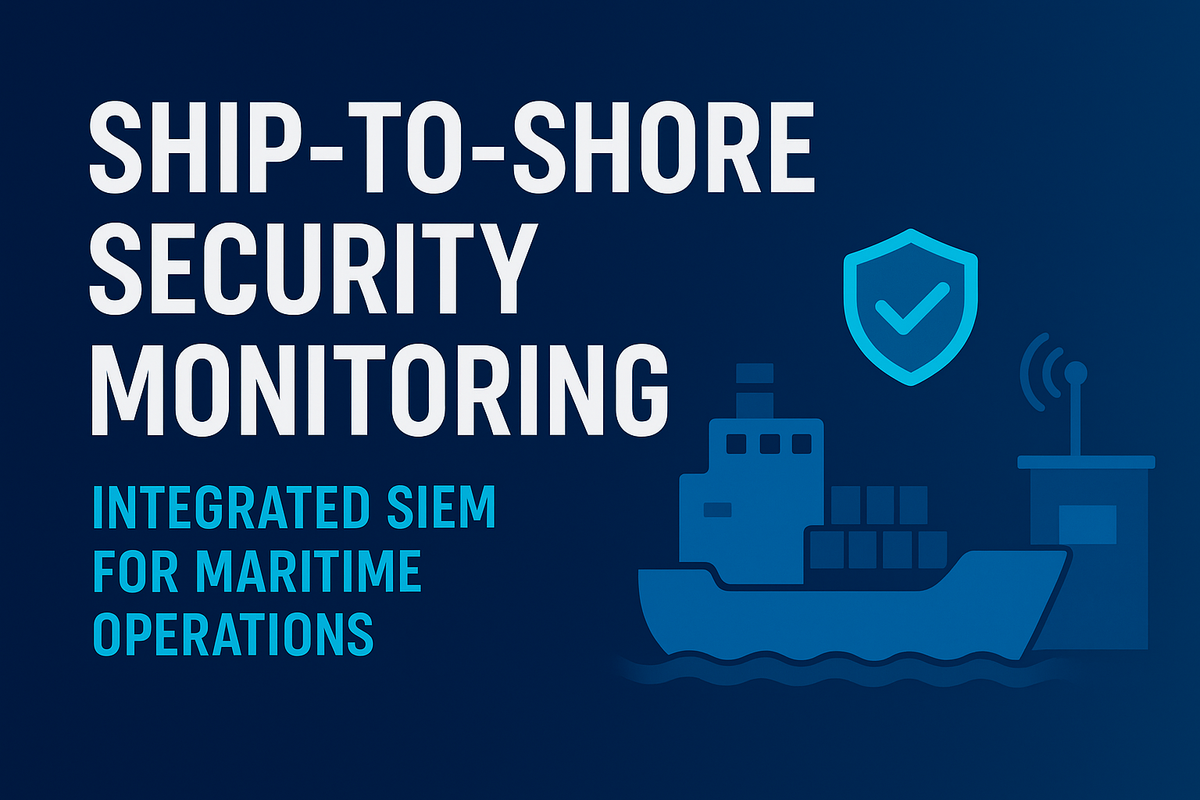Ship-to-Shore Security Monitoring: Integrated SIEM for Maritime Operations

Introduction: The Critical Need for Maritime Security
Maritime operations face unique cybersecurity challenges due to remote operations, heterogeneous vessel types, a mix of legacy OT and modern IT systems, and increased digitalization across supply chains. Ship-to-shore connectivity introduces new vulnerabilities, further exacerbated by intermittent communications and a threat landscape that now includes ransomware, supply chain attacks, and state-sponsored espionage targeting OT systems. An integrated SIEM is thus essential for threat monitoring, incident response, and real-time risk management in such a complex environment.
SIEM Fundamentals for Maritime Operations
Key Components:
- Data collection from on-board IT/OT networks, communication channels, and shore-side systems.
- Real-time aggregation, normalization, and correlation of logs and telemetry.
- Enrichment through threat intelligence feeds adapted for maritime threats.
- Automated alerting, incident response, and compliance reporting.
Unique Challenges:
- Diverse vessel architectures and network topologies.
- Periodic or low-bandwidth satellite connectivity.
- Regulatory mandates under IMO guidelines and GDPR.
Ship-to-Shore Security Monitoring: Core Concepts
Integration Points
- Onboard Systems: Navigation, engine controls, cargo management, crew devices, and local ICS/PLCs.
- Ship-to-Shore Links: VSAT, radio, cellular, and WiFi communications to company HQ/SOCs.
- Cloud and Shore-Based Systems: Fleet management, ERP, logistics, vendors.
Use Cases for Integrated SIEM
- Detecting unauthorized logins or lateral movement between vessels and shore offices.
- Identifying anomalous traffic patterns in critical control networks—e.g., sudden surges or command injection attempts in navigation systems.
- Responding to malware outbreaks, ransomware, or supply chain compromise during port calls.
Implementation Roadmap
1. Readiness Assessment and Planning
- Audit existing vessel and shore infrastructure: map critical assets and data flows.
- Define solution scope based on vessel types, routes, operational risk profiles, and compliance obligations.
2. SIEM Deployment and Log Shipping
- Select a SIEM platform capable of shipboard deployment, edge aggregation, and supporting intermittent upload to shore SOCs.
- Configure log sources: onboard firewalls, PLCs, OT gateways, navigation/ECDIS, crew endpoints, and communications gear.
- Ship logs securely using encryption, batching where connectivity is limited.
3. Threat Detection and Correlation
- Develop correlation rules tailored to maritime-specific risks, such as:
- Remote access attempts during port stays.
- Unusual engineering workstation behavior.
- Unknown device plug-in events (USB drives on bridge terminals).
- Integrate global maritime threat intelligence feeds—e.g., piracy/phishing campaigns targeting the shipping sector.
4. Incident Response and OT/IT Convergence
- Automated alerting to shoreside SOCs with vessel-specific context.
- Playbooks for both onboard and remote (shore-based) incident management.
- Drills and red team exercises reflecting maritime workflows and physical consequence scenarios.
5. Compliance Reporting and Continuous Improvement
- Alignment with IMO 2021 Cyber Guidelines, GDPR, and flag/port state controls.
- Automated evidence collection and reporting for audits.
- Ongoing SIEM tuning: review of false positives, adaptation for new operational patterns, and integration with EDR/IDS on vessels.
Best Practices and Lessons Learned
- Network segmentation between OT and IT to constrain lateral movement.
- Strong access controls: enforce MFA, least privilege, and role separation.
- Regular software patching, even on vessels with legacy OS or critical uptime constraints.
- Regular review and update of incident response procedures.
- Dedicated training for crew and operations staff on cyber hygiene and SIEM-generated alerts.
Industry Case Studies
- Real-world deployments show that integrated SIEMs can detect previously unnoticed OT attacks, enforce regulatory compliance more efficiently, and improve resilience even where network connectivity is a limiting factor.
Conclusion
Integrated SIEM for ship-to-shore security monitoring is not just a compliance checkbox—it is a strategic enabler for safe, efficient, and resilient maritime operations in a digital-first era. The most successful programs take a phased, risk-based, and context-driven approach, investing in both technology and operational processes for ongoing improvement and adaptation.
Take the Next Step with CodeSecure Solutions
Cyber threats are growing more sophisticated every day. With a trusted partner by your side, you can safeguard your business while focusing on what truly matters—growth and innovation.
At CodeSecure Solutions, we deliver comprehensive cybersecurity services in Chennai, uniquely tailored for startups, SMEs, and enterprises:
- Vulnerability Assessment & Penetration Testing (VAPT)
- Network Security Solutions
- Compliance Support (ISO 27001, PCI-DSS, HIPAA, DPDP Act, GDPR)
- Cloud & Endpoint Protection
- Security Awareness Training
No matter your industry or size, CodeSecure customizes solutions to fit your needs—ensuring your data, reputation, and operations remain secure.
Ready to Strengthen Your Defenses?
- 📞 Call: +91 73584 63582
- ✉️ Email: [email protected]
- 🌐 Visit: www.codesecure.in
Stay secure. Stay informed. Choose CodeSecure Solutions—your partner in cyber resilience.
